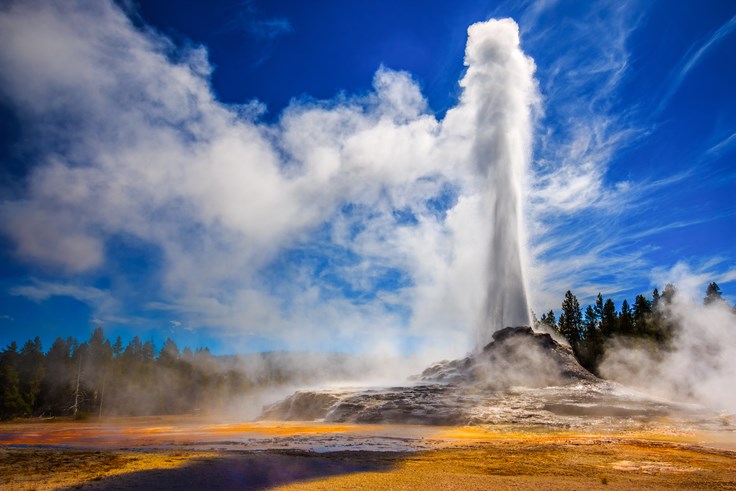NASA proposes to save the world from the threat of Yellowstone Supervolcano for $ 3 billion

Now in various media news often related to the Yellowstone Caldera . This geological site is a volcanic caldera in Yellowstone National Park in the northwestern United States. The object is often called supervolcano . In the 60s and 70s of the last century, scientists determined the size of the caldera. It is 55 * 72 km, which is about a third of the territory of the national park of the same name. The region itself is located above the so-called hot spot. Here the molten rock of the mantle moves towards the surface.
Earlier there have been eruptions. So, in the same 60s of the last century, scientists discovered the ruins of an ancient crater. Below it in our time is a huge bubble of hot magma, and the depth of this bubble is more than 8 kilometers. At the moment, it is known about three eruptions of the Yellowstone volcano, which repeatedly led to natural disasters, the nature of which is close to a nuclear winter. Scientists believe that if something like this happens in our time, it could trigger a global catastrophe - not only of a natural, but also of a social nature.
The last time the volcano erupted 70,000 years ago, and very few people want it to happen today. Unfortunately, it is difficult to say when an eruption will occur. Many media speculate on this, but in the case of Yellowstone, scientists say that the explosion will not happen during the lives of living people. Nevertheless, this threat is significant, and NASA proposes to begin work on its elimination now. Currently, supervolcano is not erupting, as there is a natural mechanism for magma cooling in Yellowstone. In the caldera, 70% of the energy of a magmatic bubble takes up the process of heating the surrounding rocks, from which water carries away excess temperature. An external manifestation of this process are geysers. And another 30% is spent on the gradual melting of rocks. Just melting is dangerous - it entails a new eruption. A number of specialists are sure that the question should not be put “Will there be an eruption?”, But “When will it happen?”.

When the supervolcano wakes up, most of the territory of the national park will be destroyed (which is the lesser of misfortunes), lava will spill out (also not very scary, this is a local phenomenon) and a huge amount of ash and gases will be released into the atmosphere. This is already a serious problem, since the region is agricultural; after the eruption, ash will cover the region with a diameter of 800, if not more. The thickness of the "precipitation" in this case will be about 4 cm, which will not allow to conduct any agricultural activity. Ash that enters the atmosphere will reduce the amount of solar radiation entering the Earth. As a result, climate change will occur - and this concerns not only the United States.
Acid rain will fall regularly across the globe, but most of them will still be in the United States.
So what is NASA going to do? The agency plans to drill two wells on the sides of the caldera, outside the national park. It is dangerous to drill closer to the center, as this could provoke an eruption. But at the edges, scientists say, you can drill without problems. Water will be supplied to one of the wells under pressure, which, when heated, will begin to flow out of the opposite well.
According to scientists, if you pass a sufficient amount of water through the volcano, this will allow a little to cool the magma near the surface. Well, the steam escaping from another well (its temperature will reach about 350 degrees Celsius) can be started up for a good cause - electricity generation.

According to representatives of NASA, this project should cause interest among energy companies that are engaged in geothermal systems. In this case, however, it will be necessary to drill a little deeper than usual, but still such a task is fully within the capabilities of modern companies. The short-term goal is to generate energy that can be supplied to hundreds or even thousands of local households. Long-term - prevention of eruption that will affect all of humanity.
Unfortunately, for the implementation of this plan requires more than $ 3 billion. To be precise, then $ 3.6 billion. Volcano cooling will take thousands of years. But on the other hand, the locals all the time will be able to get inexpensive electricity. NASA now does not have three extra billions, since the agency’s budget has already been cut. But if energy companies are interested in the idea, then all this can be quite realized. At least try.
All Articles